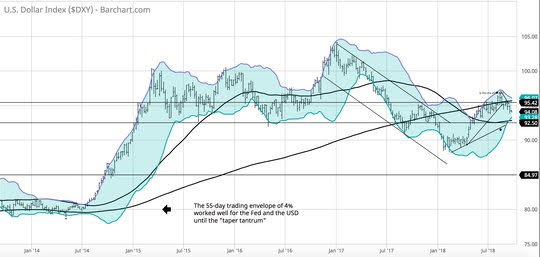Knowing how to lose is an essential part of success. If timing is the key for getting into a trade, risk management, or cutting your losses, is the key for getting out. The overnight mood has been one about losing as the US seems to not be winning the trade war. Paradoxically, neither does China. Anyone exposed to global trade suffered last night as China calls off the trade talks with the US ahead of the tariffs and watching to see further US retaliation for their new reactionary tariffs. The ability to reflect all of this headline news was further complicated by the lack of markets as both Japan and China are closed today. This is how losing begins, slowly, then quickly, just like bankruptcy. The focus this morning is on Europe and its lower equities, higher oil prices thanks to OPEC ignoring Trump’s push for more output and the USD is stable thanks to the FOMC meeting later this week. Oil at 4-year highs matters – it will push inflation fears and focus on pass-through risks along with margin compression. Growth also remains a concern as trade wars erode confidence. The German IFO was the key economic report overnight and it slipped again, but not as much as feared. The future outlook is still below the current condition indicating slowing momentum. The Italian budget debate rages on and its enveloped the fragile coalition leading to a pain trade in BTPs. The Brexit debate rages on and its led to a plan B for UK May – talk of a snap election. The push for a Canada style free trade deal is next. Of course, today in the US brings more about the US debt and its risks for future trouble as the Treasury sells bills and 2Y notes. The USD focus is on US rates being higher and it’s just not mattering like it did earlier this year. The focus on 93.90 and risk for 92.50 seems obvious and whether that correlation matters to stocks.

Question for the Day: Does the US deficit drive? The pro-cyclical budget of the President leaves the FOMC watching higher growth, lower employment and waiting for the inflation to happen. At the beginning of the year, the FOMC was expected to hike faster because of the tax reform and the risk for faster growth driving up inflation. The lack of such has been the Goldilocks story for equities in the US and left many scratching their heads for how to outplay the passive money flows. For the rest of the world, higher US rates, higher oil prices, and more trade barriers means trouble for anyone leveraged. US government spending means funding from the rest of the world and that leaves the USD as a key measure for how much the rate and risk premium matter.













Leave A Comment